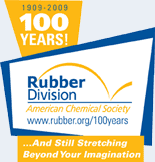![[ Visit ACS Rubber Website ]](images/logo.jpg) |
|
Centennial Elite SponsorsBecome a Centennial Elite Sponsor |
52 Effect of Aging on the Permeability Properties of Bromobutyl Based Tire Innerliner CompoundsTuesday, October 13, 2009: 2:00 PM
327 (David L. Lawrence Convention Center )
Every compound processed in a tire manufacturing plant will have a shelf life defining the maximum time between initial mixing, calendering, extruding, and finally, tire building and tire curing. A broad range of factors are important in setting the shelf life of tire compounds. Regarding bromobutyl rubber based innerliner compounds, several factors are of interest such as the tire component dimensional stability, viscosity, tack, and impermeability. In this specific study, permeability is of primary consideration with a focus on the effect of natural rubber level, representing the impact of adding non-original materials as part of tire plant work away specifications, and then the effect of time, temperature, and cure state.
Addition of natural rubber and by inference, natural rubber based compounds to an all-bromobutyl rubber compound results in an increase in permeability. However, neither long term aging or cure state resulted in a significant shift in permeability properties. High temperature aging will result in a decrease in permeability. BIMSM (EXXPROTM) and nanocomposite formulation compounds tend to show a more stable set of properties regarding both high temperature aging and long-term ambient aging. The results in this study may assist in setting both factory compound work-away outlets and also innerliner compound shelf life specifications so that only the highest quality compound is used in the tire innerliner, and in turn ensure the tire meets its performance requirements. |









